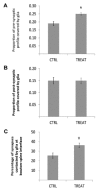Maternal dietary loads of alpha-tocopherol increase synapse density and glial synaptic coverage in the hippocampus of adult offspring
- PMID: 24998923
- PMCID: PMC4083323
- DOI: 10.4081/ejh.2014.2355
Maternal dietary loads of alpha-tocopherol increase synapse density and glial synaptic coverage in the hippocampus of adult offspring
Abstract
An increased intake of the antioxidant α-Tocopherol (vitamin E) is recommended in complicated pregnancies, to prevent free radical damage to mother and fetus. However, the anti-PKC and antimitotic activity of α-Tocopherol raises concerns about its potential effects on brain development. Recently, we found that maternal dietary loads of α-Tocopherol through pregnancy and lactation cause developmental deficit in hippocampal synaptic plasticity in rat offspring. The defect persisted into adulthood, with behavioral alterations in hippocampus-dependent learning. Here, using the same rat model of maternal supplementation, ultrastructural morphometric studies were carried out to provide mechanistic interpretation to such a functional impairment in adult offspring by the occurrence of long-term changes in density and morphological features of hippocampal synapses. Higher density of axo-spinous synapses was found in CA1 stratum radiatum of α-Tocopherol-exposed rats compared to controls, pointing to a reduced synapse pruning. No morphometric changes were found in synaptic ultrastructural features, i.e., perimeter of axon terminals, length of synaptic specializations, extension of bouton-spine contact. Glia-synapse anatomical relationship was also affected. Heavier astrocytic coverage of synapses was observed in Tocopherol-treated offspring, notably surrounding axon terminals; moreover, the percentage of synapses contacted by astrocytic endfeet at bouton-spine interface (tripartite synapses) was increased. These findings indicate that gestational and neonatal exposure to supranutritional tocopherol intake can result in anatomical changes of offspring hippocampus that last through adulthood. These include a surplus of axo-spinous synapses and an aberrant glia-synapse relationship, which may represent the morphological signature of previously described alterations in synaptic plasticity and hippocampus-dependent learning.
Conflict of interest statement
Conflict of interests: the authors declare no conflict of interest, having no commercial relationships to products or companies related to the subject matter of the article.
Figures



References
-
- Azzi A. Molecular mechanisms of α-tocopherol action. Free Radic Biol Med 2007;43: 16-21 - PubMed
-
- Azzi A, Gysin R, Kempná P, Munteanu A, Negis Y, Villacorta L, et al. Vitamin E mediates cell signaling and regulation of gene expression. Ann NY Acad Sci 2004;1031: 86-95 - PubMed
-
- Rimbach G, Fisher A, Stoecklin E, Barella L. Modulation of hepatic gene expression by alpha tocopherol in cultured cells and in vivo. Ann NY Acad Sci 2004;1031: 102-108 - PubMed
-
- Galli F, Azzi A.Present trends in vitamin E research. Biofactors 2010;36: 33-42 - PubMed
-
- Brigelius-Flohe R, Kelly FJ, Salonen JT, Neuzil J, Zingg JM, Azzi A. The European perspective on Vitamin E: current knowledge and future research. Am J Clin Nutr 2002;76: 703-716 - PubMed
Publication types
MeSH terms
Substances
LinkOut - more resources
Full Text Sources
Other Literature Sources
Medical
Miscellaneous

